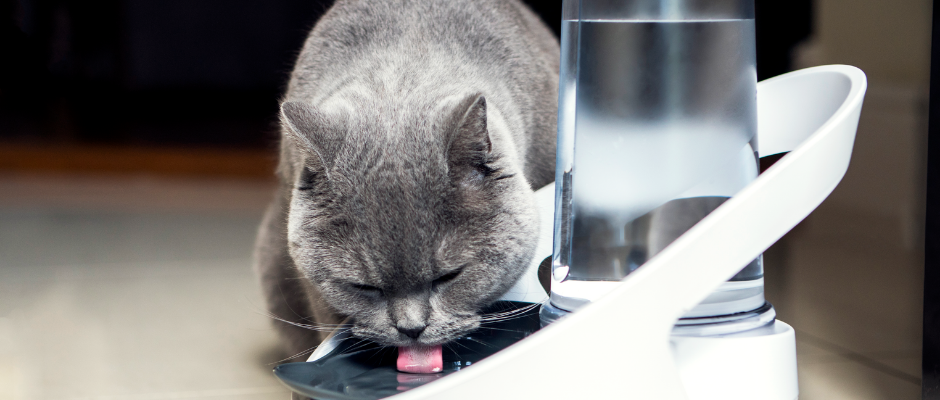Survey Says: Pet Owners Aren’t Aware of How Much Water Their Cat Is Drinking
Sure Petcare Pet Owners Survey1: How Much Water Is Your Cat Drinking?
Ensuring that a cat is drinking enough water on a daily basis is essential to their health in that it helps their organs function properly. And while it may seem insignificant, a cat’s drinking behavior is an important indicator of their overall wellbeing, and changes in those drinking patterns can be a sign that something is awry. In fact, a recent survey of 64 US veterinarians2 found that a change in water consumption was the most concerning overall health indicator in senior and middle-aged cats.
However, 48% of surveyed veterinarians2 also agreed it’s difficult to get reliable information from cat owners to support them in making an accurate diagnosis. Which then begs the question: are pet owners aware of how much water their cat is drinking?
That’s what a recent survey of 12,776 cat owners1 sought to answer. And now, the results are in.
Survey Says: There’s a Lack of Education Around Dehydration in Cats
- There are several signs of dehydration in cats3, including:
- Sunken eyes
- Increased thirst
- Listlessness/lethargy
- Loss of appetite
- Panting
- Dry, tacky gums and mouth
- Skin tenting
- Poor grooming
- Pale gums
When asked to identify the signs of dehydration in cats, 55.5% of owners didn’t recognize increased thirst as a sign1. This points to a troubling disparity between veterinarians’ knowledge of the dangers of dehydration in cats and the lack of pet owner education on those same dangers.
Further underlying the need for more education on dehydration in cats is the fact that 65% of owners never discussed feline hydration with their veterinarian, and 20% discussed it only once1. This is especially concerning since, as shown above, veterinarians agree that a change in a cat’s drinking patterns can be a key indicator of a change in health.
Survey Says: Most Cats Are Drinking Water from Their Own Bowl/Fountain
When asked where their cat regularly drinks water from, 60.1% of owners said from their own water bowl while 26.2% said from their water fountain. This is promising as this shows that the majority of cats aren’t drinking water from other sources that might harm their health, such as from the toilet.
But the survey also found some other common practices among pet owners that might be deterring their cat from drinking water. For instance, 73% of owners placed their cat’s water bowl in the kitchen, and 58.2% have the water bowl in the same room within 1 foot of the food bowl.
The kitchen might seem like an intuitive location for food and water bowls, but cats typically prefer eating and drinking in a more quiet and remote location, according to the AAFP and ISFM Feline Environmental Needs Guidelines4. Additionally, these guidelines note that food and water bowls should be separated since cats typically don’t enjoy smelling food while drinking4.
The final downside here is that while the majority of cats are drinking water from their own bowl or fountain, those sources don’t track how much water they’re drinking, which leads us to the next data point gathered from the survey.
Survey Says: Pet Owners Aren’t Aware of How Much Water Their Cat Is Drinking
Routine check-ups are essential in ensuring a pet’s health, and 67.8% of surveyed owners take their cat to the veterinarian on an annual basis. However, 67.9% of owners also said they couldn’t give their veterinarian an accurate answer if asked how much their cat drinks each day—and understandably so.
It can be difficult to keep an eye on a cat every second of every day, and there isn’t an easy or effective way to track a cat’s drinking patterns—until now.
Tracking How Much Water a Cat Is Drinking with Felaqua® Connect
To help close the educational gap between veterinarians and pet owners, Felaqua Connect was designed with the help of veterinary behaviorists to give pet owners the ability to learn more about their cat’s unique drinking patterns. Here’s how it works.
By syncing with a cat’s microchip, Felaqua Connect tracks how much, how often, and when a cat drinks. This data is then compiled into the Sure Petcare App, and owners are able to share that data with anyone—including their veterinarian. This enables both pet owners and veterinarians to have access to real-time and accurate data on a cat’s drinking patterns so that they can spot any changes in those patterns early.
As an added bonus, Felaqua Connect is battery operated so pet owners can easily place it anywhere in the home.
From Surveys to Solutions
As shown from both surveys of veterinarians and pet owners, there are a lot of lessons to be learned when it comes to hydration in cats. But with this essential data and products like Felaqua Connect, veterinarians and pet owners can work together to ensure the health of the felines they love and care for.
1 Sure Petcare Cat Wellness Survey of 12,776 cat owners, June – July 2021.
2 Sure Petcare survey of 64 veterinary professionals, May 2021.
3 Flowers, Amy. “Cat Dehydration: Symptoms, Causes, and Treatments.” WebMD, WebMD, 9 Feb. 2021, pets.webmd.com/cats/guide/dehydration-cats#1.
![<?php echo $store[store_name]; ?> flag](https://media.surepetcare.com/website/images/homepage_tiles/shopping-cart.png)



